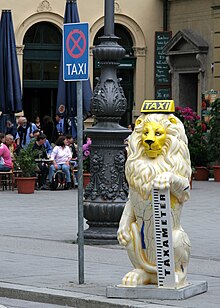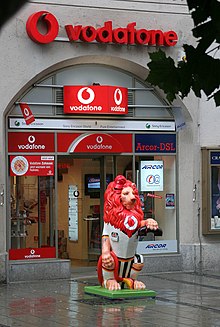Munich lion parade
The Munich Lion Parade was an action by the Münchner Löwenparade Leo eV association , during which over 500 lions made of fiberglass-reinforced plastic with mostly handcrafted painting were set up in the city of Munich from April 28, 2005 to the end of October 2006 .
Implementation of the action
The Münchner Löwenparade Leo association was founded in October 2004 to carry it out. The aim with this culture , marketing and charity project was to use the lions as an advertising medium and ambassador for Munich during the two major events, the Federal Garden Show 2005 and the Football World Cup in 2006 .
The mayor of Munich, Christian Ude , was the patron of the campaign . The entire implementation was financed by the sale of the lions to the "godparents" (mostly companies, bars, etc.) and the subsequent auction of the lions, the proceeds of which were largely donated to charitable purposes. The lion parade was financed entirely without public funds or grants. At two auctions in November 2006, 126,000 euros were raised, which were passed on to institutions for children in need (e.g. Die Arche ).
The lions became a popular photo motif for many visitors to the city, especially during the above-mentioned events. The lions that have remained to this day are still popular with children. A total of 506 lions were sold (as of December 14, 2006).
The Lions
The lions were designed in two different versions: a more realistic looking, walking lion (length 190 cm, height 122 cm) and an upright sitting lion (height 183 cm). The lions made of fiberglass-reinforced plastic weigh around 60 kg, together with the concrete base they weigh over 200 kg.
The sponsor had to spend 1,500 euros for a lion and 115 euros for the required concrete base plus 16% VAT. In addition, there were costs for acrylic paints , protective varnish and painting, which the lion owners had to take care of themselves. Many lions have been designed by professional artists. The painting produced some very imaginative results, which in some cases also met artistic requirements.
Individual lions were not only individualized by the paintwork, but also made special unique items by adding and converting or separating or removing parts of the lions . So companies z. B. Lederhosen lions lifting a beer mug or a lion that has been completely sunk into an oversized water container.
Criticism from the public and art
Occasionally it was criticized that the large number of lions spoiled the cityscape of the old town . In addition, clearly visible company logos were integrated into the painting on some copies, which according to the terms and conditions was not allowed, but was apparently tolerated.
At individual installation locations, e.g. B. on footpaths, there were bottlenecks with heavy public traffic. Overall, however, those responsible rated the campaign as a success.
Artists also dealt critically with the privatization and commercialization of public space. During the Münster exhibition, for example, Skulptur.Projekte Andreas Siekmann showed his project Trickle down - Public space in the age of privatization . To do this, he put thirteen figures of such actions, including the Munich lion, which marketing experts brought to inner cities as “city art”, in a scrap press and formed a plastic ball from them, which is set up together with the press in front of the Erbdrostenhof .
Comparable actions
Since the 1990s there have been similar campaigns in different cities in several countries, the most famous city activities are the Buddy Bears in Berlin , others: see animal parades .






